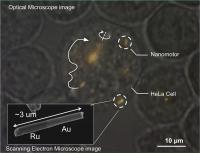Nanotechnology
NowOptical microscope image of a HeLa cell
containing several gold-ruthenium nanomotors.
Arrows indicate the trajectories of the
nanomotors, and the solid white line shows
propulsion. Near the center of the image, a
spindle of several nanomotors is spinning. Inset:
Electron micrograph of a gold-ruthenium
nanomotor. The scattering of sound waves from
the two ends results in propulsion.
Credit: Mallouk lab, Penn State University
Abstract:
For the first time, a team of chemists and
engineers at Penn State University have placed
tiny synthetic motors inside live human cells,
propelled them with ultrasonic waves and steered
them magnetically. It's not exactly "Fantastic
Voyage," but it's close. The nanomotors, which
are rocket-shaped metal particles, move around
inside the cells, spinning and battering against the
cell membrane.
Nanomotors are controlled, for the first time,
inside living cells
University Park, PA | Posted on February 10th,
2014
"As these nanomotors move around and bump
into structures inside the cells, the live cells show
internal mechanical responses that no one has
seen before," said Tom Mallouk, Evan Pugh
Professor of Materials Chemistry and Physics at
Penn State. "This research is a vivid
demonstration that it may be possible to use
synthetic nanomotors to study cell biology in new
ways. We might be able to use nanomotors to
treat cancer and other diseases by mechanically
manipulating cells from the inside. Nanomotors
could perform intracellular surgery and deliver
drugs noninvasively to living tissues."
The researchers' findings will be published in
Angewandte Chemie International Edition on 10
February 2014. In addition to Mallouk, co-authors
include Penn State researchers Wei Wang, Sixing
Li, Suzanne Ahmed, and Tony Jun Huang, as well
as Lamar Mair of Weinberg Medical Physics in
Maryland U.S.A.
Up until now, Mallouk said, nanomotors have
been studied only "in vitro" in a laboratory
apparatus, not in living human cells. Chemically
powered nanomotors first were developed ten
years ago at Penn State by a team that included
chemist Ayusman Sen and physicist Vincent
Crespi, in addition to Mallouk. "Our first-
generation motors required toxic fuels and they
would not move in biological fluid, so we couldn't
study them in human cells," Mallouk said. "That
limitation was a serious problem." When Mallouk
and French physicist Mauricio Hoyos discovered
that nanomotors could be powered by ultrasonic
waves, the door was open to studying the motors
in living systems.
For their experiments, the team uses HeLa cells,
an immortal line of human cervical cancer cells
that typically is used in research studies. These
cells ingest the nanomotors, which then move
around within the cell tissue, powered by
ultrasonic waves. At low ultrasonic power,
Mallouk explained, the nanomotors have little
effect on the cells. But when the power is
increased, the nanomotors spring into action,
moving around and bumping into organelles --
structures within a cell that perform specific
functions. The nanomotors can act as egg
beaters to essentially homogenize the cell's
contents, or they can act as battering rams to
actually puncture the cell membrane.
While ultrasound pulses control whether the
nanomotors spin around or whether they move
forward, the researchers can control the motors
even further by steering them, using magnetic
forces. Mallouk and his colleagues also found
that the nanomotors can move autonomously --
independently of one another -- an ability that is
important for future applications. "Autonomous
motion might help nanomotors selectively destroy
the cells that engulf them," Mallouk said. "If you
want these motors to seek out and destroy
cancer cells, for example, it's better to have them
move independently. You don't want a whole
mass of them going in one direction."
The ability of nanomotors to affect living cells
holds promise for medicine, Mallouk said. "One
dream application of ours is Fantastic Voyage-
style medicine, where nanomotors would cruise
around inside the body, communicating with each
other and performing various kinds of diagnoses
and therapy. There are lots of applications for
controlling particles on this small scale, and
understanding how it works is what's driving us."
###
The research was funded by the National Science
Foundation (MRSEC grant DMR-0820404), the
National Institutes of Health, the Huck Innovative
and Transformative Seed Fund (HITS) and Penn
State University.
[ Krista Weidner ]
####








0 comments:
Post a Comment